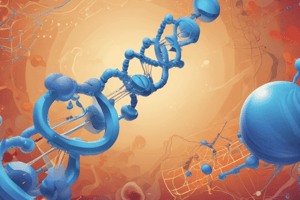Podcast
Questions and Answers
What is the area on the enzyme where the substrate attaches called?
What is the area on the enzyme where the substrate attaches called?
- Binding site
- Inhibitory site
- Catalytic site (correct)
- Inactive site
What do we call the substance at the beginning of an enzymatic reaction on which an enzyme acts?
What do we call the substance at the beginning of an enzymatic reaction on which an enzyme acts?
- Coenzyme
- Substrate (correct)
- Activator
- Inhibitor
What is the term used for an enzyme without its non-protein moiety?
What is the term used for an enzyme without its non-protein moiety?
- Coenzyme
- Apoenzyme (correct)
- Holoenzyme
- Prosthetic group
Which type of cofactor is tightly bound to the apoenzyme by covalent bonds?
Which type of cofactor is tightly bound to the apoenzyme by covalent bonds?
What is the term for a non-protein chemical compound bound to an enzyme and required for catalysis?
What is the term for a non-protein chemical compound bound to an enzyme and required for catalysis?
What type of cofactor is derived from vitamins and loosely bound to the apoenzyme by non-covalent bonds?
What type of cofactor is derived from vitamins and loosely bound to the apoenzyme by non-covalent bonds?
What is the purpose of using 1-fluoro-2-4-dinitrobenzene (DNB) in sequencing polypeptides?
What is the purpose of using 1-fluoro-2-4-dinitrobenzene (DNB) in sequencing polypeptides?
In Edman Degradation, what does phenylisothiocyanate label?
In Edman Degradation, what does phenylisothiocyanate label?
What happens if Edman Degradation is repeated several times on a polypeptide?
What happens if Edman Degradation is repeated several times on a polypeptide?
Under acidic conditions, what happens to the bonds in a polypeptide chain when reacting with Sanger Reagent?
Under acidic conditions, what happens to the bonds in a polypeptide chain when reacting with Sanger Reagent?
What is the consequence of using 1-fluoro-2-4-dinitrobenzene (DNB) on the rest of the polypeptide chain?
What is the consequence of using 1-fluoro-2-4-dinitrobenzene (DNB) on the rest of the polypeptide chain?
What allows for repeated use of phenylisothiocyanate in Edman Degradation?
What allows for repeated use of phenylisothiocyanate in Edman Degradation?
Which environmental factor has the most significant impact on enzyme activity?
Which environmental factor has the most significant impact on enzyme activity?
What is the primary mechanism by which a competitive inhibitor slows down an enzymatic reaction?
What is the primary mechanism by which a competitive inhibitor slows down an enzymatic reaction?
What is the optimal pH range for most enzymes?
What is the optimal pH range for most enzymes?
How does substrate concentration affect the rate of an enzymatic reaction?
How does substrate concentration affect the rate of an enzymatic reaction?
What is the role of cofactors in enzymatic reactions?
What is the role of cofactors in enzymatic reactions?
How do competitive inhibitors affect the $K_m$ (Michaelis constant) of an enzymatic reaction?
How do competitive inhibitors affect the $K_m$ (Michaelis constant) of an enzymatic reaction?
What is the main difference between the lock-and-key model and the induced-fit model of enzyme action?
What is the main difference between the lock-and-key model and the induced-fit model of enzyme action?
How does an enzyme increase reaction rates according to the text?
How does an enzyme increase reaction rates according to the text?
What happens within the active site of an enzyme-substrate complex?
What happens within the active site of an enzyme-substrate complex?
What is one limitation of the lock-and-key model of enzyme action?
What is one limitation of the lock-and-key model of enzyme action?
How do enzymes achieve varying degrees of specificity for substrates?
How do enzymes achieve varying degrees of specificity for substrates?
What is the overall reaction for the conversion of substrate to product in enzyme-catalyzed reactions?
What is the overall reaction for the conversion of substrate to product in enzyme-catalyzed reactions?
Which of the following statements about non-competitive inhibitors is correct?
Which of the following statements about non-competitive inhibitors is correct?
Which of the following is a common naming convention for enzymes?
Which of the following is a common naming convention for enzymes?
Which of the following is NOT one of the six functional classes of enzymes according to the International Union of Biochemists (I.U.B.)?
Which of the following is NOT one of the six functional classes of enzymes according to the International Union of Biochemists (I.U.B.)?
What is the biochemical activity of oxidoreductases?
What is the biochemical activity of oxidoreductases?
Which of the following statements about competitive inhibitors is correct?
Which of the following statements about competitive inhibitors is correct?
Which of the following is an example of a common name used for a digestive enzyme?
Which of the following is an example of a common name used for a digestive enzyme?
Flashcards are hidden until you start studying




